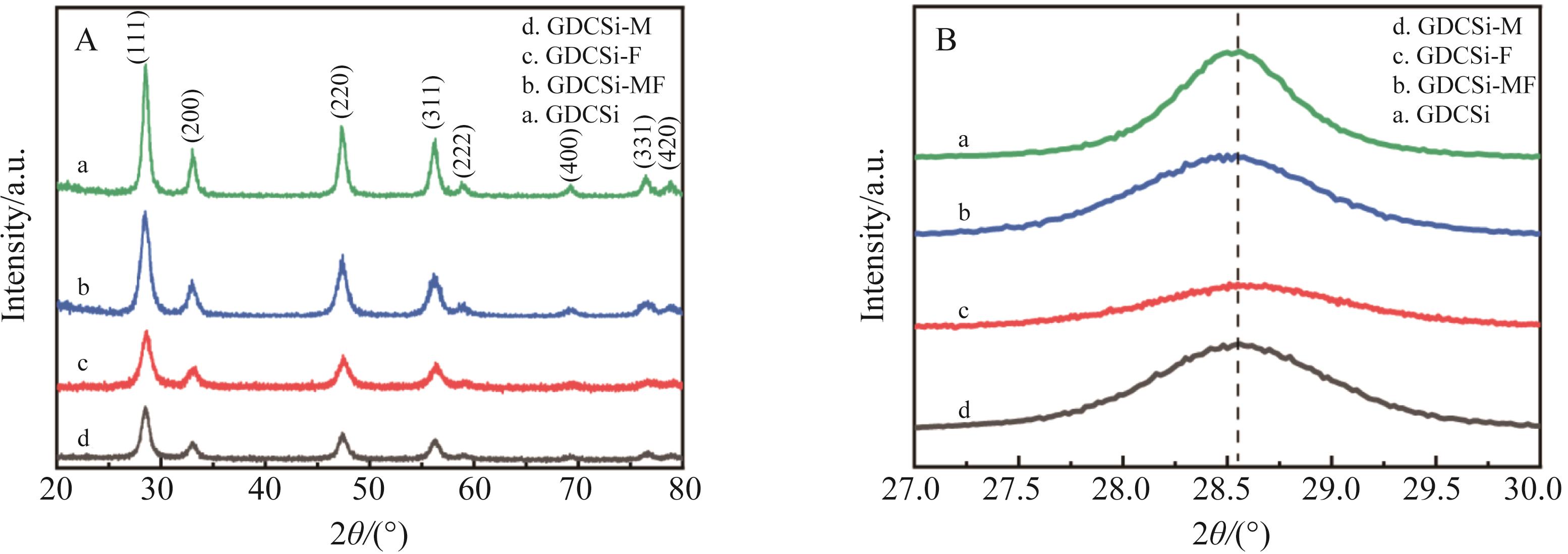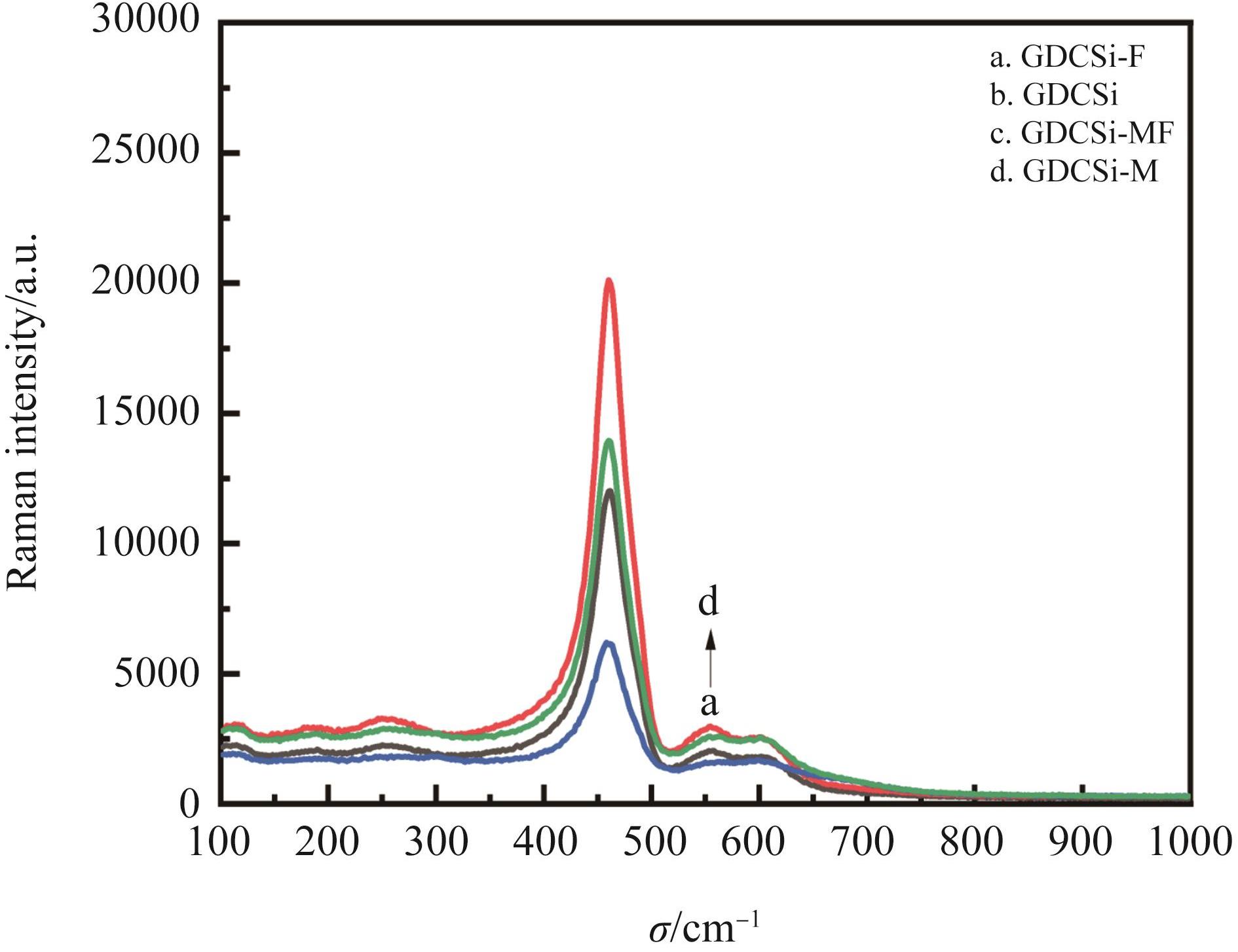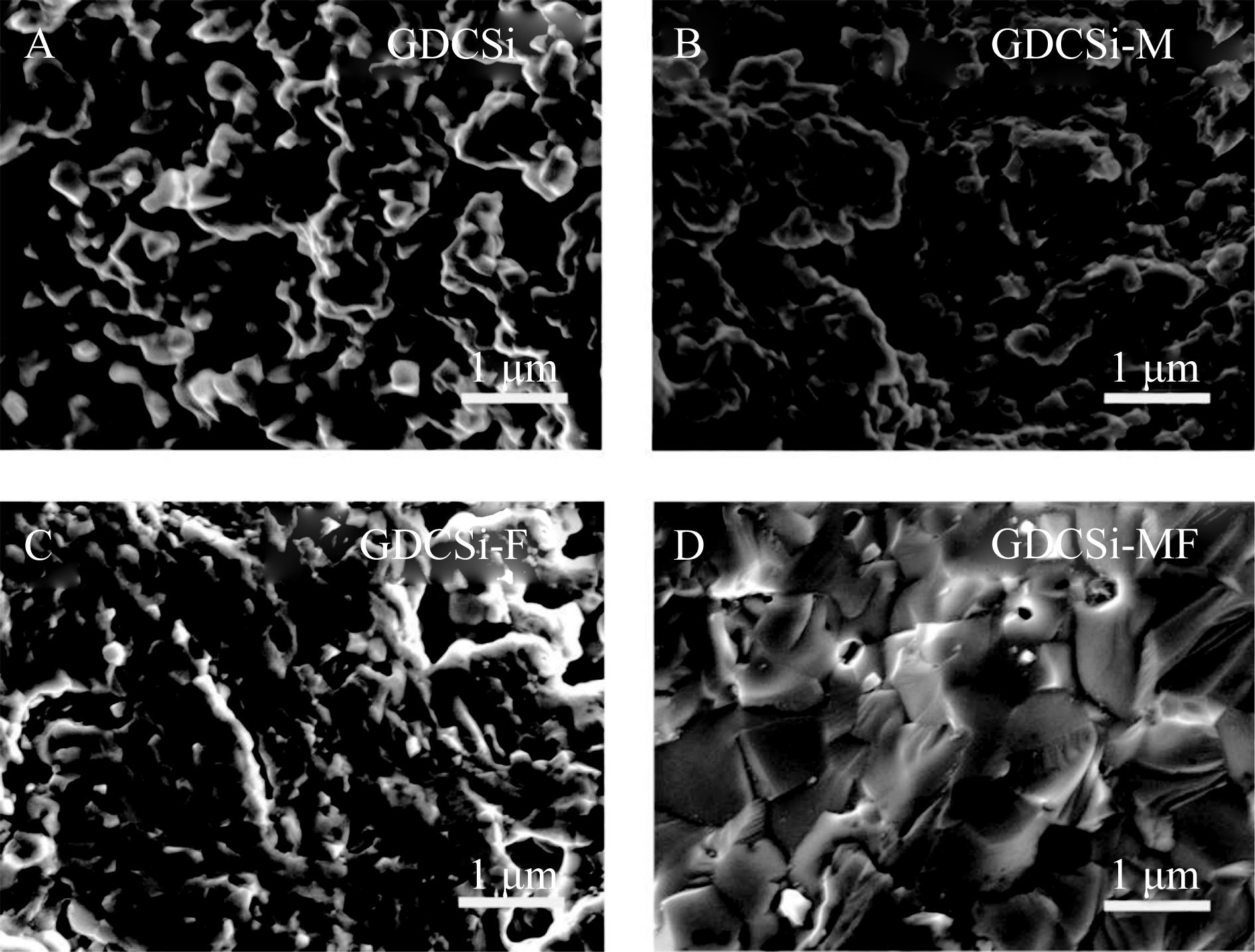
Chinese Journal of Applied Chemistry ›› 2022, Vol. 39 ›› Issue (5): 809-818.DOI: 10.19894/j.issn.1000-0518.210150
• Full Papers • Previous Articles Next Articles
Effect of MgO and Fe2O3 Incorporation on the Microstructure and Electrochemical Performance of GDCSi System
Jing ZHOU, Yu-Xuan CHEN, Jun-Ming MA, Xiao-Fei ZHU( ), De-Feng ZHOU(
), De-Feng ZHOU( )
)
- School of Chemistry and Life Science,Changchun University of Technology,Changchun 130012,China
-
Received:2021-03-29Accepted:2021-07-29Published:2022-05-01Online:2022-05-24 -
Contact:Xiao-Fei ZHU,De-Feng ZHOU -
About author:defengzhou65@126.com
zhuxiaofei@ccut.edu.cn
-
Supported by:the National Natural Science Foundation of China(21471022);the Jilin Provincial Science Research Foundation of China(20190201230JC);the 13th Five?Year Plan for Science & Technology Research Sponsored by Department of Education of Jilin Province(JJKH20200647KJ)
CLC Number:
Cite this article
Jing ZHOU, Yu-Xuan CHEN, Jun-Ming MA, Xiao-Fei ZHU, De-Feng ZHOU. Effect of MgO and Fe2O3 Incorporation on the Microstructure and Electrochemical Performance of GDCSi System[J]. Chinese Journal of Applied Chemistry, 2022, 39(5): 809-818.
share this article
Add to citation manager EndNote|Ris|BibTeX
URL: http://yyhx.ciac.jl.cn/EN/10.19894/j.issn.1000-0518.210150
样品 Samples | 晶胞参数 a/nm | 晶胞体积 V/nm3 | 理论密度 ρT/ (g·cm-3) | 实际密度 ρa/(g·cm-3) | 相对密度 ρRel/% | 微晶尺寸 d/nm |
|---|---|---|---|---|---|---|
| GDCSi | 0.541 30 | 15.860 | 7.247 | 6.203 | 85.6 | 14.85 |
| GDCSi?M | 0.541 31 | 15.861 | 7.238 | 6.608 | 91.3 | 15.40 |
| GDCSi?F | 0.541 04 | 15.837 | 7.249 | 6.879 | 94.9 | 18.51 |
| GDCSi?MF | 0.541 29 | 15.862 | 7.251 | 6.939 | 95.7 | 25.20 |
Table 1 Related parameters of GDCSi?based electrolyte sintered at 1200 ℃ for 10 h
样品 Samples | 晶胞参数 a/nm | 晶胞体积 V/nm3 | 理论密度 ρT/ (g·cm-3) | 实际密度 ρa/(g·cm-3) | 相对密度 ρRel/% | 微晶尺寸 d/nm |
|---|---|---|---|---|---|---|
| GDCSi | 0.541 30 | 15.860 | 7.247 | 6.203 | 85.6 | 14.85 |
| GDCSi?M | 0.541 31 | 15.861 | 7.238 | 6.608 | 91.3 | 15.40 |
| GDCSi?F | 0.541 04 | 15.837 | 7.249 | 6.879 | 94.9 | 18.51 |
| GDCSi?MF | 0.541 29 | 15.862 | 7.251 | 6.939 | 95.7 | 25.20 |
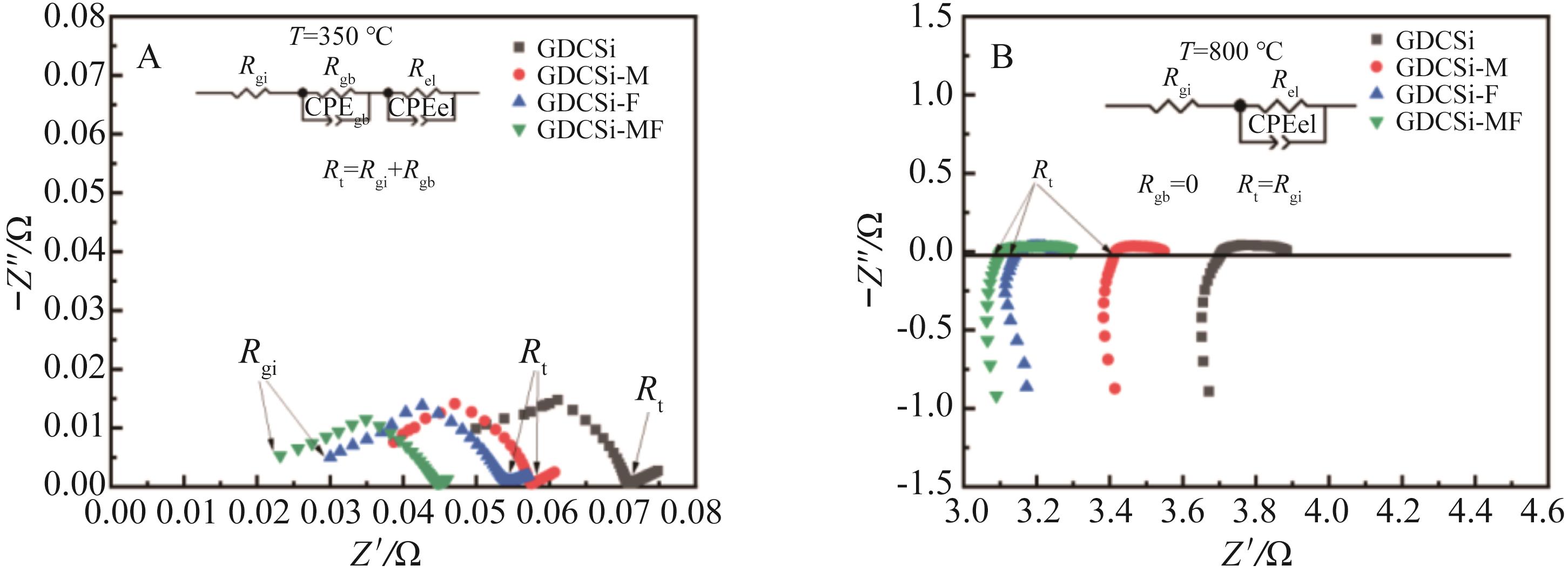
Fig.4 Electrochemical impedances of GDCSi-based electrolyte measured at (A) 350 ℃, (B) 800 ℃ in air. The illustration shows equivalent circuit diagrams for EIS analysis
样品 Samples | 350 ℃ | 800 ℃ | |||
|---|---|---|---|---|---|
晶粒电阻 Rgi/Ω | 晶界电阻 Rgb/Ω | 总电阻 Rt/Ω | 晶界电阻/总电阻 Rgb/Rt | 总电阻=晶粒电阻 Rt =Rgi/Ω | |
| GDCSi | 1218.9 | 1269.6 | 2488.5 | 0.51 | 3.71 |
| GDCSi?M | 470.61 | 138.05 | 575.22 | 0.24 | 3.42 |
| GDCSi?F | 425.78 | 119.48 | 545.26 | 0.22 | 3.14 |
| GDCSi?MF | 348.89 | 98.35 | 447.24 | 0.21 | 3.10 |
Table 2 The resistance values of GDCSi?based electrolytes measured at 350 and 800 ℃
样品 Samples | 350 ℃ | 800 ℃ | |||
|---|---|---|---|---|---|
晶粒电阻 Rgi/Ω | 晶界电阻 Rgb/Ω | 总电阻 Rt/Ω | 晶界电阻/总电阻 Rgb/Rt | 总电阻=晶粒电阻 Rt =Rgi/Ω | |
| GDCSi | 1218.9 | 1269.6 | 2488.5 | 0.51 | 3.71 |
| GDCSi?M | 470.61 | 138.05 | 575.22 | 0.24 | 3.42 |
| GDCSi?F | 425.78 | 119.48 | 545.26 | 0.22 | 3.14 |
| GDCSi?MF | 348.89 | 98.35 | 447.24 | 0.21 | 3.10 |
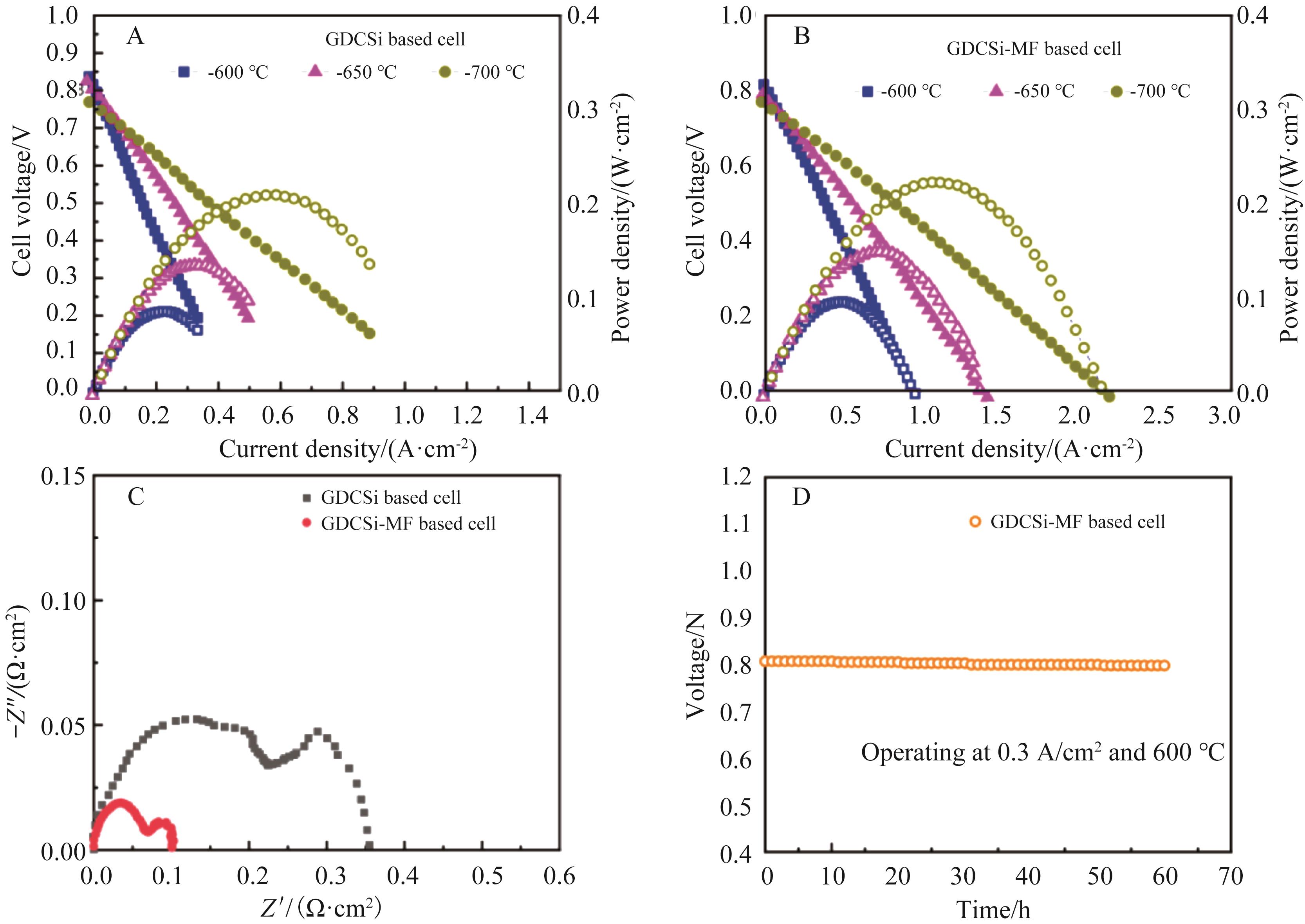
Fig.6 Peak power density (PPD) of (A) NiO-GDCSi/ GDCSi/LSCF (Cell-Ⅰ) and (B) NiO-GDCSi-MF/GDCSi-MF/LSCF (Cell-Ⅱ) at 600~700 °C. (C) Impedance spectra of single cells (Cell-Ⅰ, Cell-Ⅱ) measured at 700 °C under open circuit voltage (OCV). (D) Long-term stability test of Cell-Ⅱ is conducted for 60 h at 600 °C and at a constant current of 0.3 A/cm2
| 1 | 刘世伟, 梁亮, 李晨阳, 等. 高温质子交换膜燃料电池的复合催化层电极[J]. 应用化学, 2019, 36(9): 1085-1090. |
| LIU S W, LIANG L, LI C Y, et al. Composite catalytic layer electrode for high temperature proton exchange membrane fuel cell[J]. Chinese J Appl Chem, 2019, 36(9): 1085-1090. | |
| 2 | AUCKETT J E, ODRIOZOLA L L, CLARK S, et al. Exploring the nature of the fergusonite-scheelite phase transition and ionic conductivity enhancement by Mo6+ doping in LaNbO4[J]. J Mater Chem A, 2021, 9: 4091-4102. |
| 3 | HOSSEINPOUR J, CHITSAZ A, EISAVI B, et al. Investigation on performance of an integrated SOFC-Goswami system using wood gasification[J]. Energy, 2018, 148: 614-628. |
| 4 | CHEN X, SUN X, ZHOU J, et al. Effects of CoO and Bi2O3 single/dual sintering aids doping on structure and properties of Ce0.8Nd0.2O1.9[J]. Ceram Int, 2020, 46(14): 22727-22732. |
| 5 | PUENTE-MARTÍNEZ D E, DÍAZ-GUILLÉN J A, MONTEMAYOR S M, et al. High ionic conductivity in CeO2 SOFC solid electrolytes; effect of Dy doping on their electrical properties[J]. Int J Hydrogen Energy, 2019, 45(27): 14062-14070. |
| 6 | RAFIQUE A, AHMAD M A, SHAKIR I, et al. Multioxide phase-based nanocomposite electrolyte (M@SDC where M= Zn2+/Ba2+/La3+/Zr2+/Al3+) materials[J]. Ceram Int, 2019, 46(5): 6882-6888. |
| 7 | TOOR S Y, CROISET E. Reducing sintering temperature while maintaining high conductivity for SOFC electrolyte: copper as sintering aid for Samarium Doped Ceria[J]. Ceram Int, 2019, 46(1): 1148-1157. |
| 8 | 刘建伟, 周德凤, 杨梅, 等. MgO或Fe2O3掺杂Ce0.8Nd0.2O1.9固体电解质的结构和电性能[J]. 物理化学学报, 2012, 28(6): 1380-1386. |
| LIU J W, ZHOU D F, YANG M, et al. Structure and electrical properties of Ce0.8Nd0.2O1.9 solid electrolyte doped with MgO or Fe2O3[J]. Chinese J Phy Chem, 2012, 28(6): 1380-1386. | |
| 9 | STEELE B C H. Material science and engineering: the enabling technology for the commercialisation of fuel cell systems[J]. J Mater Sci, 2001, 5: 1053-1068. |
| 10 | XIN G, SIGLE W, MAIER J. Blocking grain boundaries in yttria-doped and undoped ceria ceramics of high purity[J]. J Am Ceram Soc, 2010, 86(1): 77-87. |
| 11 | TIAN N, QU Y, MEN H, et al. Properties of Ce0.85Sm0.15O2- δ-CuO electrolytes for intermediate-temperature solid oxide fuel cells[J]. Solid State Ionics, 2020, 351: 115331. |
| 12 | TIAN N, YU J, DENG Y F, et al. Electrical properties of Ce0.85Sm0.15O1.925-Fe2O3 electrolytes for IT-SOFCs[J]. J Alloy Compd, 2016, 655: 215-219. |
| 13 | XU D, LIU X M, XU S F, et al. Fabrication and performance of Ce0.85Sm0.15O1.925-Fe2O3 electrolytes in IT-SOFCs[J]. Solid State Ionics, 2011, 192(1): 510-514. |
| 14 | BI H L, LIU X M, ZHU L L, et al. Effect of MgO addition and grain size on the electrical properties of Ce0.9Gd0.1O1.95 electrolyte for IT-SOFCs[J]. Int J Hydrogen Energy, 2017, 42(16): 11735-11744. |
| 15 | CHO Y H, CHO P S, AUCHTERLONIE G, et al. Enhancement of grain-boundary conduction in gadolinia-doped ceria by the scavenging of highly resistive siliceous phase[J]. Acta Mater, 2007, 55: 4807-4815. |
| 16 | CHO P S, LEE S B, CHO Y H, et al. Effect of CaO concentration on enhancement of grain-boundary conduction in gadolinia-doped ceria[J]. J Power Sources, 2008, 183(2): 518-523. |
| 17 | GE L, LI R F, HE S C, et al. Enhanced grain-boundary conduction in polycrystalline Ce0.8Gd0.2O1.9 by zinc oxide doping: scavenging of resistive impurities[J]. J Power Sources, 2012: 230: 161-168. |
| 18 | XU S F, LIU J, LI K H, et al. The role of TiO2 on the microstructure and the electrochemical behavior of Ce0.8Gd0.2O2- δ for solid oxide fuel cell electrolyte[J]. J Alloy Compd, 2019, 780: 711-717. |
| 19 | ZHAO G C, ZHOU D F, ZHU J X, et al. Effect of MoO3 concentration on sintering and electrical properties of SiO2-containing neodymium-doped ceria electrolytes[J]. Solid State Sci, 2011, 13(5): 1072-1075. |
| 20 | CHO P S, CHO Y H, PARK S Y, et al. Grain-boundary conduction in gadolinia-doped ceria: the effect of SrO addition[J]. J Electrochem Soc, 2009, 156(3): B339-B344. |
| 21 | ZHANG C, SUNARSO J, ZHU Z H, et al. Enhanced oxygen permeability and electronic conductivity of Ce0.8Gd0.2O2- δ membrane via the addition of sintering aids[J]. Solid State Ionics, 2017, 310: 121-128. |
| 22 | HAN J X, ZHANG J D, LI F, et al. Low-temperature sintering and microstructure evolution of Bi2O3-doped YSZ[J]. Ceram Int, 2018, 44(1): 1026-1033. |
| 23 | MCBRIDE J R, HASS K C, POINDEXTER B D, et al. Raman and X-ray studies of Ce1- xRExO2- y, where RE=La, Pr, Nd, Eu, Gd, and Tb[J]. J Appl Phy, 1994, 76(4):2435-2441. |
| 24 | PIUMETTI M, BENSAID S, ANDANA T, et al. Nanostructured ceria-based materials: effect of the hydrothermal synthesis conditions on the structural properties and catalytic activity[J]. Catalysts, 2017, 7(6): 174. |
| 25 | SPANIER J E, ROBINSON R D, ZHANG F, et al. Size-dependent properties of CeO2- y nanoparticles as studied by Raman scattering[J]. Phys Rev B, 2001, 64(24): 245407. |
| 26 | ZHANG T S, MA J, LENG Y J, et al. Effect of transition metal oxides on densification and electrical properties of Si-containing Ce0.8Gd0.2O2- δ ceramics[J]. Solid State Ionics, 2004, 168: 187-195. |
| 27 | ZHENG Y, ZHOU M, GE L, et al. Effect of Fe2O3 on Sm-doped ceria system solid electrolyte for IT-SOFCs[J]. J Alloy Compd, 2011, 509: 546-550. |
| 28 | ZHANG T S, MA J, CHAN S H, et al. Improvements in sintering behavior and grain-boundary conductivity of ceria-based electrolytes by a small addition of Fe2O3[J]. J Electrochem Soc, 2004, 151(10): J84-J90. |
| 29 | STEELE B C H. Appraisal of Ce1- yGdyO2- y/2 electrolytes for IT-SOFC operation at 500 ℃[J]. Solid State Ionics, 2000, 129(1-4): 95-110. |
| 30 | LEAH R T, BRANDON N P, AGUIAR P. Modelling of cells, stacks and systems based around metal-supported planar IT-SOFC cells with CGO electrolytes operating at 500~600 ℃[J]. J Power Sources, 2005, 145(2): 336-352. |
| 31 | WANG J Q, CHEN X, XIE S K, et al. Bismuth tungstate/neodymium-doped ceria composite electrolyte for intermediate-temperature solid oxide fuel cell: sintering aid and composite effect[J]. J Power Sources, 2019, 428: 105-114. |
| 32 | ZHANG Y, KNIBBE R, SUNARSO J, et al. Recent progress on advanced materials for solid-oxide fuel cells operating below 500 °C[J]. Adv Mater, 2017, 29(48): 1700132. |
| 33 | LIN D, WANG Q, PENG K, et al. Phase formation and properties of composite electrolyte BaCe0.8Y0.2O3- δ-Ce0.8Gd0.2O1.9 for intermediate temperature solid oxide fuel cells[J]. J Power Sources, 2012, 205: 100-107. |
| 34 | ZHAO L, DRENNAN J, KONG C, et al. Insight into surface segregation and chromium deposition on La0.6Sr0.4Co0.2Fe0.8O3- δ cathodes of solid oxide fuel cells[J]. J Mater Chem A, 2014, 2(29): 11114-11123. |
| [1] | Peng BU, Hong-Liang LI. Preparation and Upconversion Luminescence Study of Rare Earth Yb3+/Tm3+ Doped NaGd(MO4)2 Phosphors [J]. Chinese Journal of Applied Chemistry, 2023, 40(3): 374-379. |
| [2] | Lu-Fei WANG, Meng-Meng ZHEN, Bo-Xiong SHEN. Research Progress of Controlling Lithium-Sulfur Batteries by Electrocatalysts under Lean Electrolyte Conditions [J]. Chinese Journal of Applied Chemistry, 2023, 40(2): 188-209. |
| [3] | Xue-Jian SHI, Wan-Qiang LIU, Chun-Li WANG, Yong CHENG, Li-Min WANG. Research Progress of Sb-based Anode Materials for Potassium Ion Batteries [J]. Chinese Journal of Applied Chemistry, 2023, 40(2): 210-228. |
| [4] | Xin GU, Wen-Qing WANG, Jun-He HOU, Lu GAO, Ming-Hua HUANG, Ge SU. Advances of Inorganic‑inorganic Composite Electrochromic Films [J]. Chinese Journal of Applied Chemistry, 2022, 39(9): 1345-1359. |
| [5] | En-Tong WANG, Lin-Fang YANG. Preparation and Properties of LiNi0.6Co0.2Mn0.2O2 Cathode Material for High Specific Capacity Lithium Ion Battery [J]. Chinese Journal of Applied Chemistry, 2022, 39(8): 1209-1215. |
| [6] | Qiao-Zhi GUO, Zhen-Hua YANG, Yue-Xia ZHANG, Ya-Ting MENG, Yu-Juan CAO, Xuan-Sen SUN, Qi-Qi ZHANG, Shao-Min SHUANG, Chuan DONG. Synthesis and Applications of Graphene Quantum Dots Derived from Citric Acid [J]. Chinese Journal of Applied Chemistry, 2022, 39(6): 888-899. |
| [7] | You-San ZHOU, Yi-Cheng ZHANG, Si-Yu WU, Fei ZHA, De-Jun CHEN, Yue CHANG. Catalytic Performance of Cu‑Doped Calcium Aluminum Layered Double Hydrotalcites for the Oxidation of Cumene to Cumene Hydrogen Peroxide [J]. Chinese Journal of Applied Chemistry, 2022, 39(6): 941-948. |
| [8] | Song-Song XUE, Zheng-Feng XIE, Jia-Wei HE, Tian-Yi ZHANG, Bao-Ping XIA, Yu-Qin LI. Synthesis of Sulfonylhydrazone Probe with High Selectivity and Rapid Identification of Hg(Ⅱ) Ion and Its Application in Adsorption [J]. Chinese Journal of Applied Chemistry, 2022, 39(5): 760-768. |
| [9] | Lin-Hu SONG, Shi-You LI, Jie WANG, Jing-Jing ZHANG, Ning-Shuang ZHANG, Dong-Ni ZHAO, Fei XU. Research Progress of Additives for Acid and Water Removal in Electrolyte of Lithium Ion Battery [J]. Chinese Journal of Applied Chemistry, 2022, 39(5): 697-706. |
| [10] | Qi ZHANG, Qian ZHANG, Xiao-Meng SHI, Ya-Qi KONG, Ke-Xin GAO, Ya-Ping DU. Research Progress of Rare Earth Bromides Based Solid Electrolytes for All⁃Solid⁃State Batteries [J]. Chinese Journal of Applied Chemistry, 2022, 39(4): 585-598. |
| [11] | Hui DU, Chen-Yang YAO, Hao PENG, Bo JIANG, Shun-Xiang LI, Jun-Lie YAO, Fang ZHENG, Fang YANG, Ai-Guo WU. Applications of Transition Metal⁃doped Iron⁃based Nanoparticles in Biomedicine [J]. Chinese Journal of Applied Chemistry, 2022, 39(3): 391-406. |
| [12] | Zhong XU, Jun LI, En-Hui WU, Yan JIANG. Influence of Vanadium Tailings on the Thermal Stability and Electrical Conductivity of Expanded Graphite/ Paraffin Composite Phase Change Materials [J]. Chinese Journal of Applied Chemistry, 2022, 39(3): 461-469. |
| [13] | Tong CAO, Jun PENG, Yan FENG, Xiao-Bo LIU, Yu-Min HUANG. Research Progress of Side-Chain Sulfonated Polyarylene Ether Proton Exchange Membranes [J]. Chinese Journal of Applied Chemistry, 2022, 39(12): 1783-1802. |
| [14] | Ying ZHAO, Yi-Jia SHAO, Luo-Qian LI, Jian-Wei REN, Shi-Jun LIAO. Research Progress on the Degradation Mechanism and Cycle Stability Improvement of Lithium-Rich Cathode Materials [J]. Chinese Journal of Applied Chemistry, 2022, 39(02): 205-222. |
| [15] | WANG Xu-Yao, FANG Ying-Jun, ZHANG Ling-Zhi. Synthesis and Characterization of Cross-linked Solid Polymer Electrolyte Based on N-Cyanoethylated Polyethylenimine for Lithium-Ion Batteries [J]. Chinese Journal of Applied Chemistry, 2021, 38(8): 946-953. |
| Viewed | ||||||
|
Full text |
|
|||||
|
Abstract |
|
|||||
